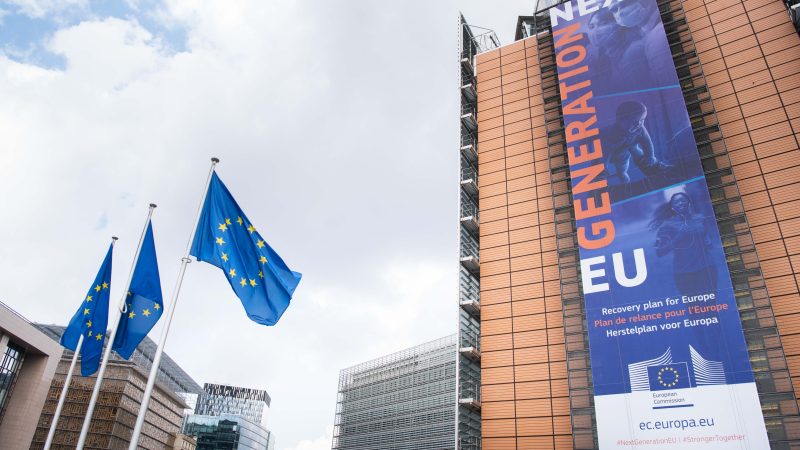NGOs warned of “opacities” in the way the pandemic recovery funds have been designed and spent across a number of European countries, which have often locked citizens out from decisions affecting them.
“There has been a massive lack of public involvement and participation in designing and actually implementing the recovery funds,” Daniel Thomson, policy officer at CEE Bankwatch Network, told EURACTIV.
“The decisions on how and where to invest these funds have been really taken behind closed doors, without properly involving civil society, the public or relevant stakeholders,” he added, pointing to the findings of a recent report analysing recovery funds spending in Bulgaria, Estonia, Hungary, Italy, Latvia, Poland and Spain.
Lack of transparency
The report, published by the Citizens’ Observatory for Green Deal Financing, found that the public was not involved in the design of the national recovery plans and was often not given tools to monitor their implementation.
“In Italy, there has been opacity since the beginning, because the government did not let the parliament see the draft recovery plan until three days before presenting it to the Commission,” said Eva Pastorelli, campaigner at the Italian NGO ReCommon.
While there were positive investments, “the plan had no bottom-up approach and it has not been easy for territories and communities to co-programme the investments based on their needs,” she said.
On top of this, civil society organisations encountered difficulties in finding and accessing information regarding the projects funded, pointing to a lack of transparency for the public.
“We’ve really struggled to find a lot of information about what’s actually been financed and who are the beneficiaries. So the fact that civil society has really been struggling to find this information means that citizens have not been involved at all,” Thomson said.
As the funds needed to be spent over a short period of time, in some cases the period available for public consultation was shortened, to respect the deadlines imposed.
“There was a lack of transparency and time for people to really assess if infrastructure was really needed,” said Pastorelli, pointing to the example of a breakwater in Genoa, a €2 billion infrastructure project which NGOs said has been carried out without citizen involvement and could potentially damage sea biodiversity.
The lack of involvement at the local level was criticised by the European Parliament in a report adopted in June 2022, which called on member states to “ensure clarity in the distribution of responsibilities and adequate management systems of RRF [recovery and resilience] funds to take into consideration the specific needs of the citizens at regional and local levels.”
Against public interests
“Failing to include civil society in making these decisions led to a series of investments that don’t really reflect the interests of the general public,” Thomson said.
According to the report, investments under the national recovery plans often went to large companies rather than SMEs or the public sector or towards big infrastructure projects which could potentially harm the environment.
“The recovery funds were supposed to help people and those countries especially hit by the COVID pandemic and recover by creating more resilient economies,” said Bruna Cañada Roca from the Debt Observatory in Globalisation, adding however that the money has not reinforced the healthcare system or other public services.
“The whole decision-making process was just a dialogue between the national government and the European Commission and the management was very centralised,” she said, explaining that a social dialogue table for the recovery created in Spain included only representatives of two trade unions.
A lack of staff and resources has also prevented municipalities and regions as well as social enterprises from accessing the funds, she added.
In other countries, however, citizen participation had more influence on decisions taken on the spending of funds.
In Poland, for instance, the construction of a hydro project on Vistula was criticised and removed from the recovery plan.
“The lower citizens’ involvement, the higher risk bad projects are included in the plan,” Krzysztof Mrozek from the Polish Green Network told EURACTIV, adding that strict eligibility criteria also prevented projects which could be beneficial for local communities to be funded through the EU recovery funds.
Better involvement
The authors of the report also conducted a survey among citizens finding low levels of awareness regarding EU recovery funds and citizen involvement in the decisions taken by the governments.
In the survey, respondents suggested increasing the use of social media, television, radio and podcasts to raise awareness.
To boost involvement of citizens, respondents also pointed to the possibility of introducing mandatory public participation or setting up citizens’ assemblies at the city level allowing inhabitants to exchange about their needs.
“National authorities, the member states, see public participation as a really bureaucratic kind of red tape and tick-the-box exercise, whereas in fact, they should view it as a real asset to align spending with the needs of the citizens,” Thomson said.
By: Silvia Ellena
Date: 4 jul 2023
Image: European Comission
Link: https://www.euractiv.com/section/participatory-democracy/news/eu-citizens-poorly-involved-in-recovery-funds-design-and-spending-report-shows/?utm_source=dlvr.it
